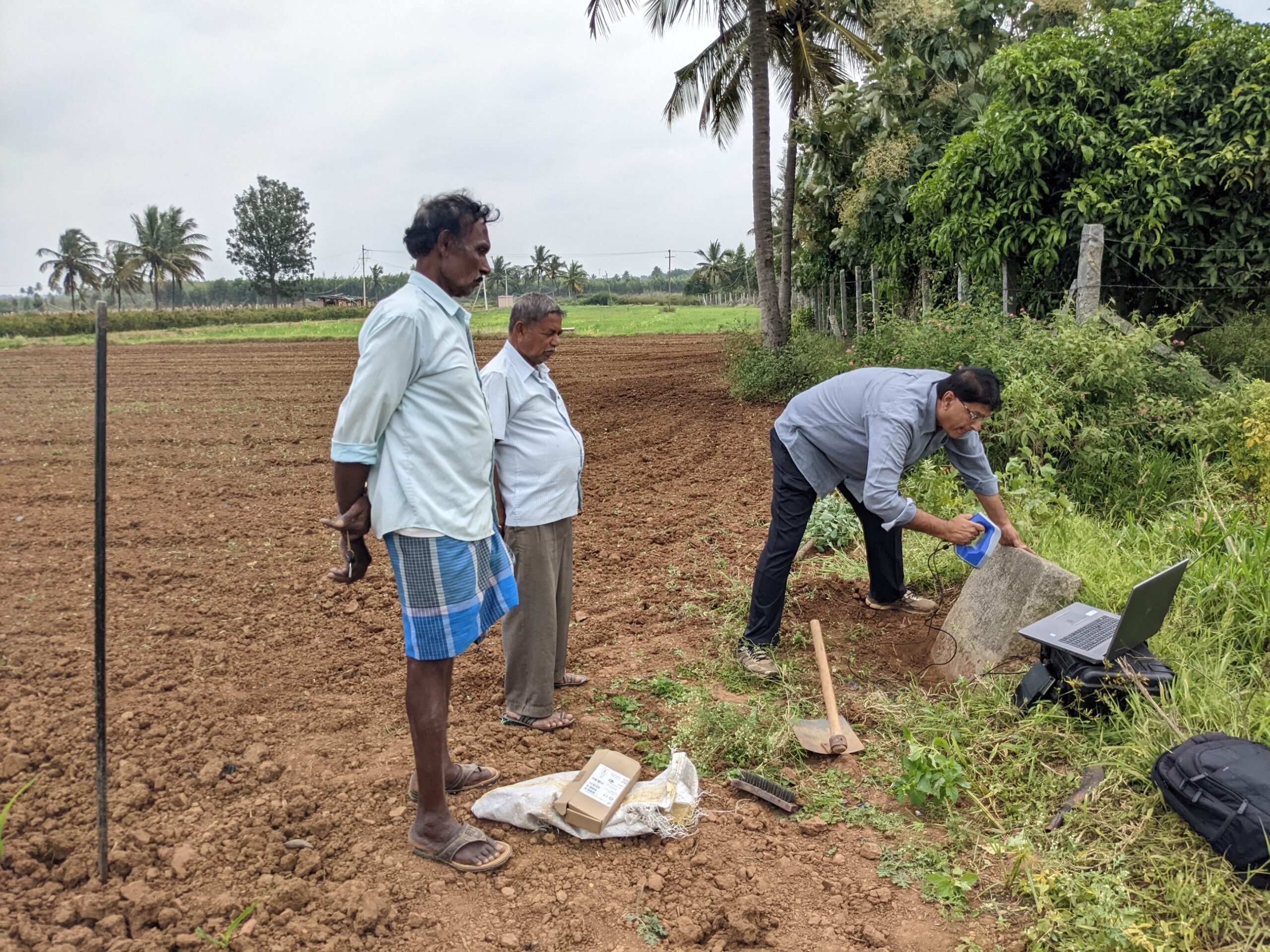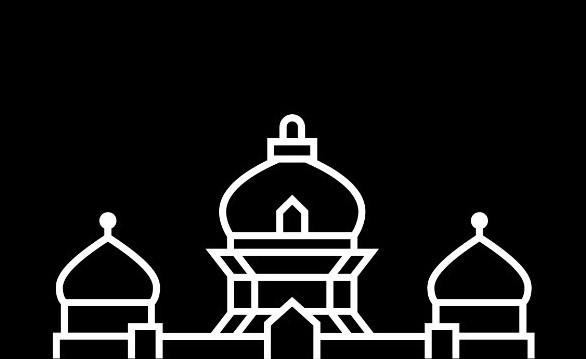Stones that tell stories
The Mythic Society Bengaluru Inscriptions 3D Digital Conservation Project was started in 2021 with the goal of scanning and documenting historic inscription stones in and around the city. Bengaluru.com met the Honorary Director Udaya Kumar P L to talk about the past, present and future of this well-known project.
When I was growing up in Rajajinagar, it was known by the villages that made up the extension. One of the villages was Ketamaranahalli. There is a first K block where the K stands for Ketamaranahalli. In 2017, someone told me that there was an inscription stone from the 13th century which carried that name. There was an event by ICHR (Indian Council of Historical Research) where Dr B S Shyalaja, then Director of the Nehru Planetarium was going to talk about epigraphy. She invited me to the event saying that there would be a lot of experts who could help me find this stone. But, when I tried, one of the experts said I was just wasting my time. Instead of discouraging me, this curt response made me more determined to find the stone. I found the book Epigraphia Carnatica compiled by Benjamin Lewis Rice online and this gave me the location near the Ketamaranahalli lake along with the text on the inscription stone. But there was a problem. There was no known lake in that area for the past hundred years. I found an 18th century map that showed a lake where Mariyappanapalya Park now exists, but there was nothing at the spot indicated by the book.
Ultimately, we never found any trace of that stone and then I went looking for another one from the 8th century in nearby Peenya. Later, I went to other places like Yeshwantpur, Marathahalli, Vibhutipura looking for more such stones. I knew the remaining stones were not going to survive for long and started writing about this on Facebook. Coming from a technology background, what we needed was digital model of the stones before they were lost or destroyed. The only way to do this was to use good commercial scanners but these were very expensive costing more than $25,000 each. Altem Technologies who made the Artec scanners were interested in heritage conservation, so they offered to scan a few and build models for free. Soon, this became my weekend activity.
I was doing weekend walks to show people these inscription stones. At this time Mythic Society had heard of this work and invited me for a talk and a demonstration. About 200 people including many experts came to the event. They were impressed and asked me to write about this for their magazine The Quarterly Journal. In addition, they asked me to repeat the talk and were interested to know how much it would cost to scan and document inscription stones around Bengaluru. At the same time, I was trying to raise funds to buy a scanner through CSR funding, but it did not yield any results. So, I prepared a project proposal for about ₹4 to ₹5 crores and gave it to the Mythic Society. They agreed to fund it and asked me to manage the project. I asked for some time to wind up my current job responsibilities and agreed to work with them as an honorary director of the project.
We had a plan to put together a team, procure equipment and execute this over a three-year period starting in January 2021. It was a very opportune moment for me but also a difficult decision to switch. My family also supported me in my decision because they saw the value of such a project.
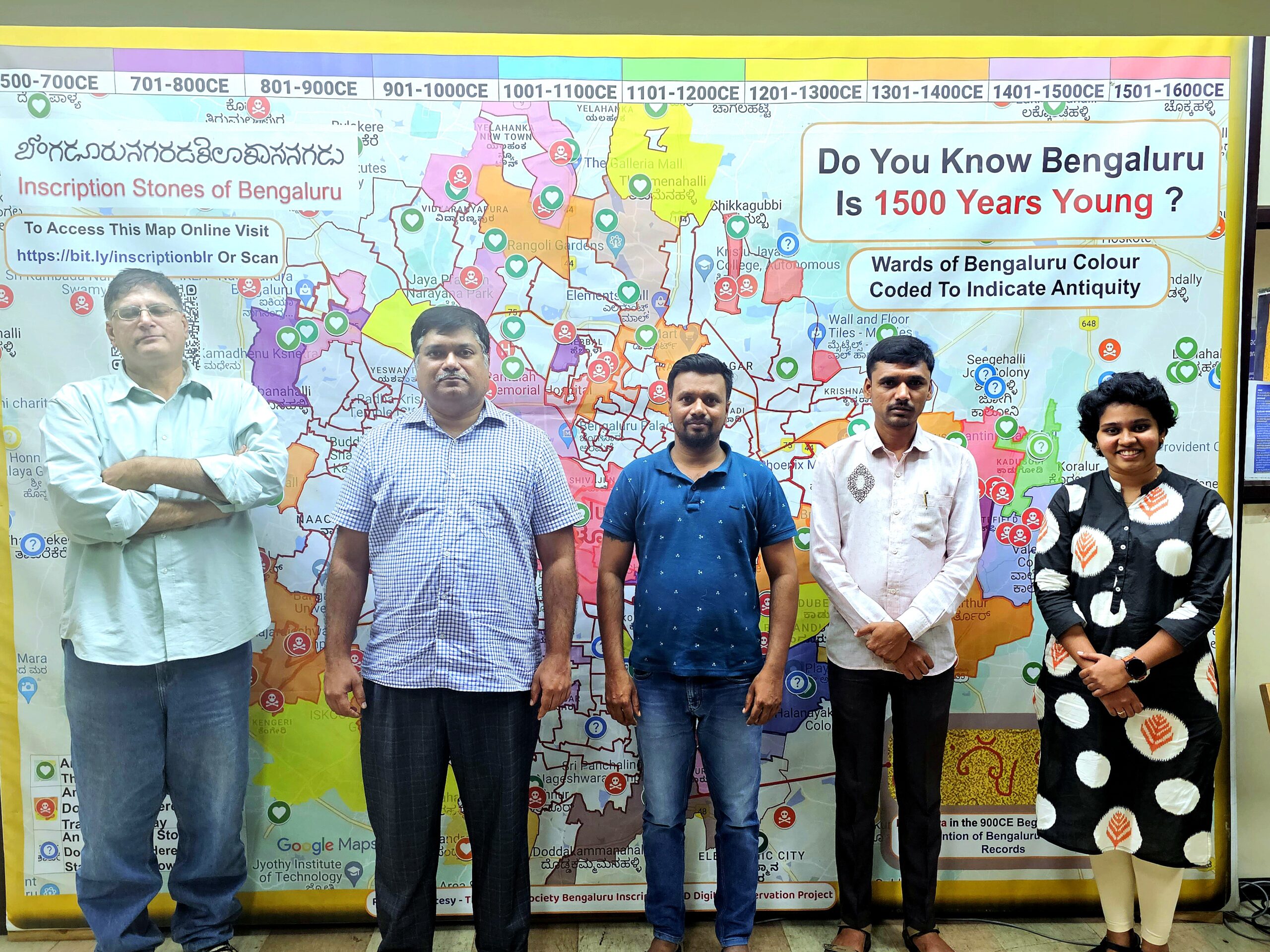
My team consists of highly qualified people and in fact, I am a novice compared to them. Madhusudhana has a PhD in history from Mysore University with a focus on temples of Hassan taluk, Shashikumar Naik is currently doing PhD in Tumkur University specialising in deciphering old languages, Gautam is in the final stages of getting a PhD in numismatics and Anusha has completed her MA in History from Deccan College and is aspiring to do a PhD in future. They are all young and enthusiastic with technology awareness.
Most of what we know as history has been gathered from inscription stones. It records something significant at that particular place. It could be someone building a village or a lake or a temple. These are very selective, notable events. Looking at many such stones, you can determine the period, the ruler, the dominant religion or God worshipped in the region.
These stones are perhaps the only source of original information because everything else is something handed down from one generation to another. Since these stones were installed in public places, it automatically gains authenticity because no one can falsify such information.
Benjamin Lewis Rice, who founded the Mysore Archaeological Department, documented all these stones in the book Epigraphia Carnatica between 1892 and 1905. He discovered about 6500 inscriptions in the old Mysore region. We collected this information and mapped it using Google Maps.
Every stone location starts with a question mark as we don’t know if it still exists. Once we go to the location, it changes to a green heart if found or a red skull if it is lost or destroyed. When it is scanned we mark it in purple colour. We use an advanced field survey app for this purpose, ask questions, add photos and videos to document it. We try to prioritise by surveying the most endangered stones first. Many have to be set upright, cleaned up because it is faded or someone painted over it. Then we scan the stone and upload it into our computer system. Many of these may have been read before and published but we read it again as our models have higher quality resolution and sometimes make corrections to earlier readings.
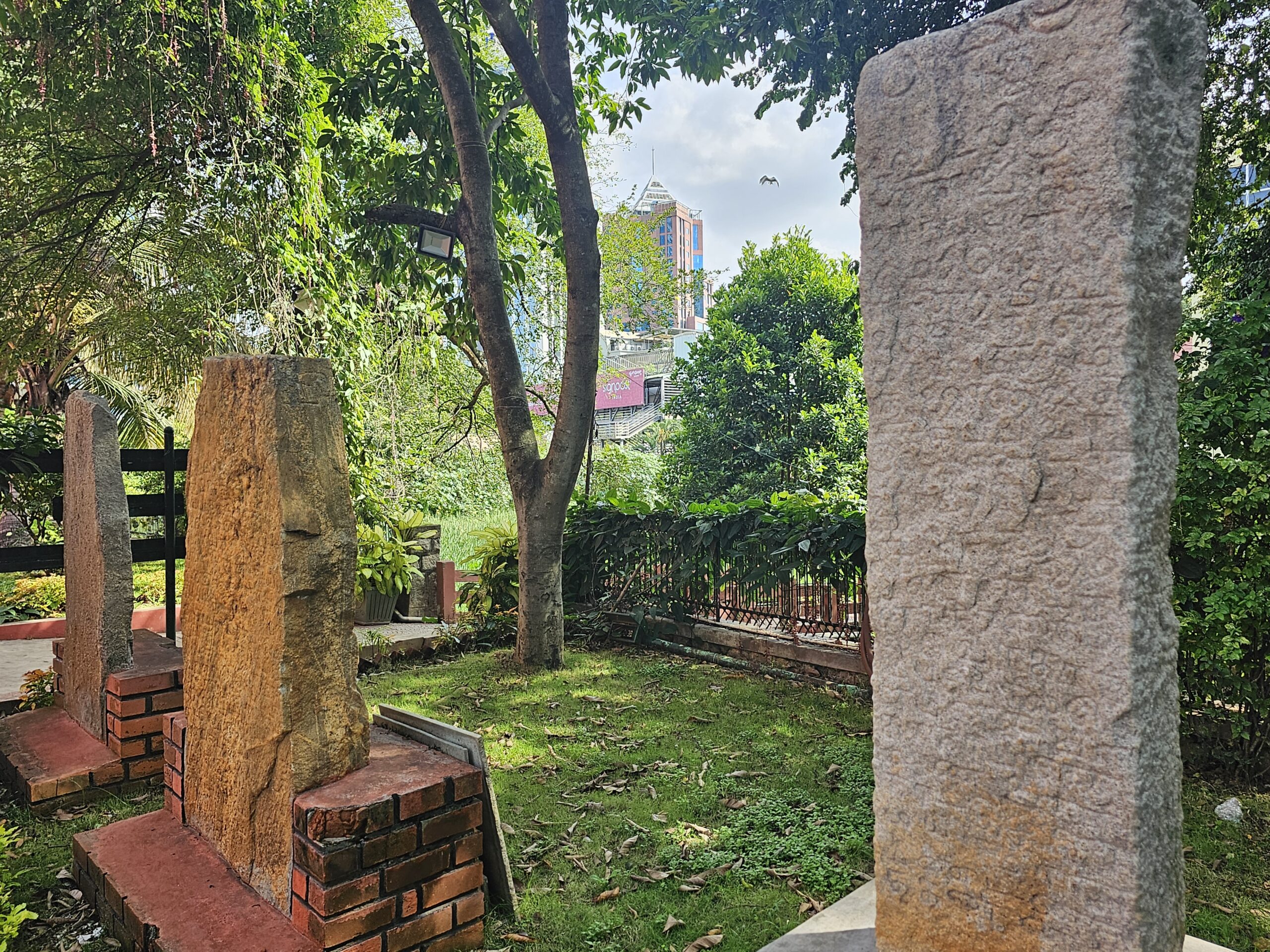
Usually local people know of the inscription stone sites even if it is in unusual places such as rocks or even cemeteries. Some shepherd would have taken his flock to graze there or some kids would have played in that area. Yes, we do find inscriptions in the most unimaginable places. Something with an inscription will rarely be thrown away, but it may be reused in some way. Over time we have learnt where and how to find them.
Many stones have a date on them, so that is not a problem. The shape and size of the script can also tell us from which period as can the names of the kings on the stones. References to the people tell us the period. Every letter from the inscription is separated and our software will compare it against the database we have for the alphabets. This catalog shows the pattern or form of alphabets every 100 years, so when we get a new one, we can compare and tell the approximate period.
We work in Bengaluru Urban, Bengaluru Rural and Ramanagara districts adding up to a total of 6000 square kilometers, which is massive and bigger than even some countries.
Our initial goal was to complete 1500 inscription stones in 3 years. We have surveyed about 1000 and another 500 are left. About 500 have been scanned. We hope to complete the remaining work in about 2 years or less. So, we are trying to balance between conservation and awareness. We have scanned about 500 stones but what is written on them has not been shared with the world, so we want to bring it out as a book. This work has been going on for about 4 months but took quite a bit of our time. We decided to pause the book work and complete rest of the scanning first. Because every day we lose, another stone may be at risk. About 30 to 40 percent of the stones have been lost in urban areas, 20 to 30 percent in rural areas. But the project will not be done until we write about all the stones.
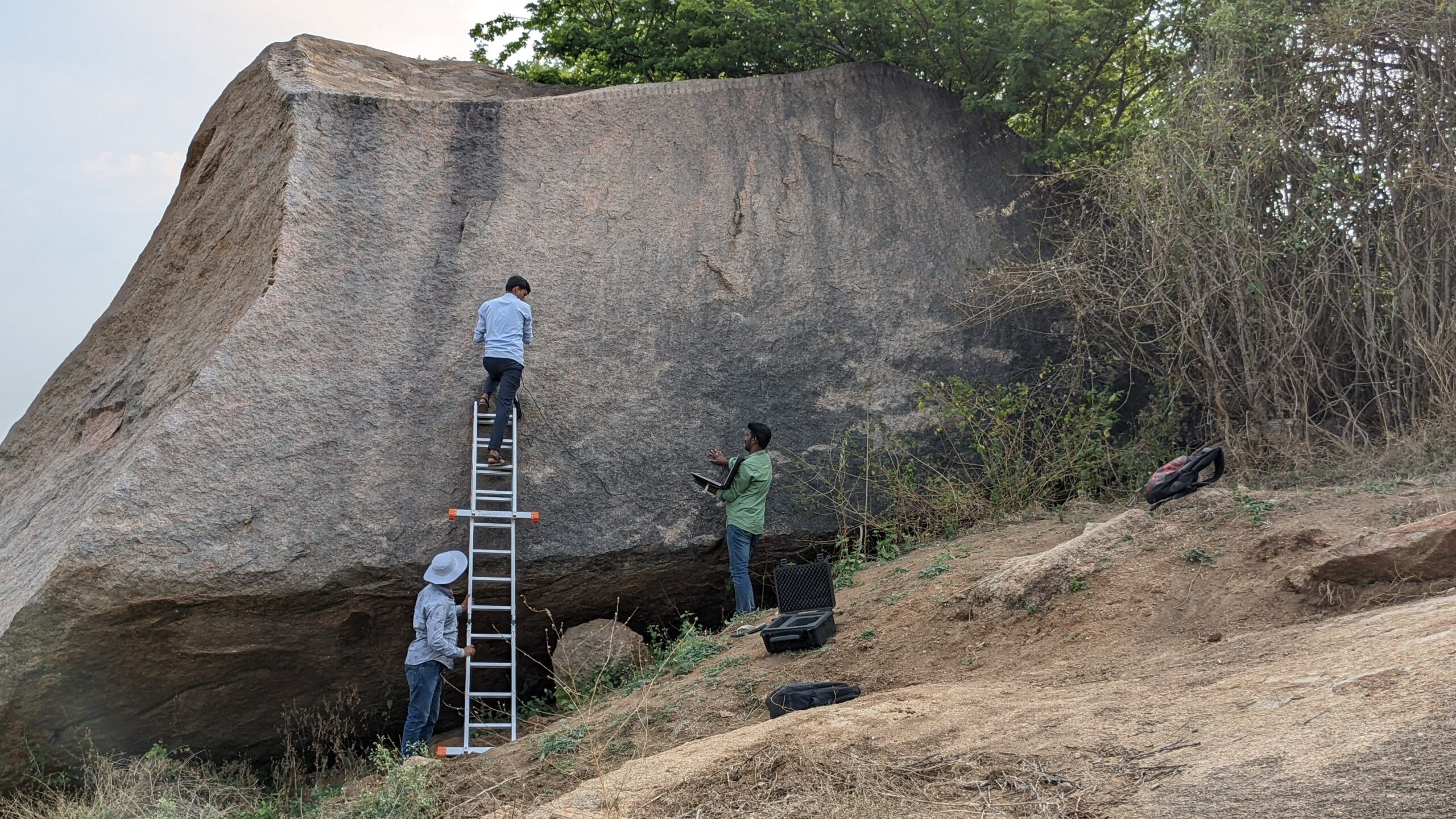
Our day usually starts at 7 or 7:30 am as we are generally working about 50 – 60 kms from the city. We have a vehicle full of digging equipment along with scanners, cameras and laptops. Once we reach, we start around 10:30 or 11 am, work until about 5 pm with a lunch break in the middle and return back to the city around 7 or 7:30 pm. We spend 2 or 3 days on the field and rest of the time here. For a stone of about 5 feet by 0.5 feet we need about an hour to 90 mins of scanning time at the site. It will take another day to process it on our system and upload it to our database. The biggest challenge sometimes is accessibility to the inscription stone site. Sometimes, we have to use ladders to climb onto rocks with great difficulty.
Local people are fascinated when we tell them the story from the stones found in their place. Many are unaware that their place had a rich history going back hundreds of years. When we demonstrate our technology students love it, but teachers are not that impressed. We have unfortunately failed to convince historians or epigraphists that these are good methods. Fundamentally, there are two problems – one they do not believe in using new technology in their field. Remember how banks reacted to computerisation in the 80s or 90s? They did not understand it, so they saw it as a threat. Secondly, conservation was never on their mind. They thought this was not of any interest to the common man and was a topic only for academia.
Within walking distance of anywhere in Bengaluru you can find sculptures, inscriptions. You can see, touch and feel so much history. But it goes beyond that. We had the UK Science and Technology minister come and the High Commission requested us to show him something science and technology related in the inscription field. I showed a stone from Kodigehalli which was about the donation of the village (“Kodige” means gift or endowment) at the time of a solar eclipse. This has a date of August 8, 1431 on it. We verified that an eclipse had actually happened on that date using a eclipse database that covers 5000 years. There was only a few minutes of difference between local calculations and the documented time. So, it showed how advanced astronomy was at that time and you can infer that it was a literate and advanced society.
My goal is that every Bengalurean should know the story and history of the area. Bengaluru is the fastest growing city in the world which means it is a happening place. Every product, whether it is a car, aircraft engine or phone that we use today will have a Bengaluru contribution to it. Where else in the world can you be in a city known for high tech but also has a history of thousands of years? My dream is to make this knowledge commonplace. With that knowledge should come a sense of pride and belonging. This will make Bengaluru a much better place in future.
